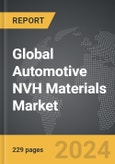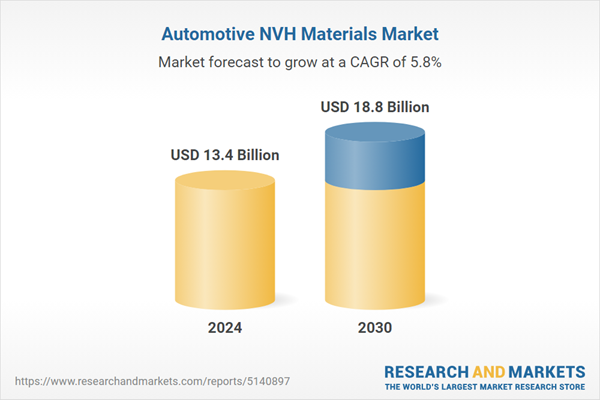The global market for Automotive NVH Materials was valued at US$13.4 Billion in 2024 and is projected to reach US$18.8 Billion by 2030, growing at a CAGR of 5.8% from 2024 to 2030. This comprehensive report provides an in-depth analysis of market trends, drivers, and forecasts, helping you make informed business decisions. The report includes the most recent global tariff developments and how they impact the Automotive NVH Materials market.
Segments: Type (Rubber, Foam, PVC, Metal sheet, Cork, Other Types); Application (Floor Module, Cockpit Module, Trunk Module, Wheel Arches, Other Applications); End-Use (Passenger Cars, Light Commercial Vehicles, Heavy Commercial Vehicles).
Geographic Regions/Countries: World; United States; Canada; Japan; China; Europe (France; Germany; Italy; United Kingdom; Spain; Russia; and Rest of Europe); Asia-Pacific (Australia; India; South Korea; and Rest of Asia-Pacific); Latin America (Argentina; Brazil; Mexico; and Rest of Latin America); Middle East (Iran; Israel; Saudi Arabia; United Arab Emirates; and Rest of Middle East); and Africa.
The analysts continuously track trade developments worldwide, drawing insights from leading global economists and over 200 industry and policy institutions, including think tanks, trade organizations, and national economic advisory bodies. This intelligence is integrated into forecasting models to provide timely, data-driven analysis of emerging risks and opportunities.
Global Automotive NVH Materials Market - Key Trends and Drivers Summarized
Why Are Automotive NVH Materials Critical To Modern Vehicle Design?
Automotive Noise, Vibration, and Harshness (NVH) materials are integral to the design and engineering of modern vehicles, playing a vital role in enhancing the overall driving experience by minimizing unwanted noise and vibrations. These materials are strategically placed throughout the vehicle to absorb, dampen, or block noise and vibrations that originate from the engine, road, and wind, contributing to a quieter and more comfortable cabin environment. As consumer expectations for vehicle comfort continue to rise, automakers are increasingly focusing on NVH materials to differentiate their products in a competitive market. In addition to improving passenger comfort, effective NVH management is crucial for maintaining the integrity of various vehicle components, reducing the risk of wear and tear caused by excessive vibrations. The importance of NVH materials has only grown with the advent of electric vehicles (EVs), where the absence of engine noise has made other sources of sound more prominent, requiring even more sophisticated NVH solutions.How Are Technological Advancements Shaping The Future Of NVH Materials?
Technological advancements are significantly transforming the development and application of NVH materials in the automotive industry, leading to more effective and innovative solutions. One of the key trends is the integration of lightweight materials that not only meet NVH requirements but also contribute to overall vehicle weight reduction, a critical factor in improving fuel efficiency and extending the range of electric vehicles. Advanced composites, foams, and hybrid materials are being developed to offer superior noise absorption and vibration damping properties while maintaining or even reducing the weight of the vehicle. Additionally, the use of computer-aided engineering (CAE) and simulation tools allows engineers to predict NVH performance early in the design process, optimizing material selection and placement for maximum effectiveness. The rise of smart materials, which can adapt to changing environmental conditions, is also opening new possibilities for NVH management, providing dynamic responses to noise and vibration levels in real-time.What Challenges And Opportunities Are Present In The Automotive NVH Materials Market?
The automotive NVH materials market is characterized by a range of challenges and opportunities as it evolves alongside advancements in vehicle technology and consumer demands. One of the primary challenges is balancing the need for effective NVH solutions with the growing emphasis on vehicle lightweighting. As manufacturers strive to reduce vehicle weight to improve efficiency, there is a constant need to innovate and develop materials that offer the necessary NVH performance without adding excessive weight. Another challenge lies in the shift towards electric and autonomous vehicles, which present unique NVH issues that differ from those in traditional internal combustion engine vehicles. However, these challenges also present significant opportunities. The increasing demand for premium vehicles with superior cabin comfort is driving the adoption of high-quality NVH materials. Additionally, the growth of electric vehicles is creating new avenues for NVH solutions that address the specific needs of quieter, battery-powered cars. Furthermore, the development of eco-friendly and sustainable NVH materials is gaining traction, aligning with broader industry trends towards sustainability and environmental responsibility.What Factors Are Driving Growth In The Automotive NVH Materials Market?
The growth in the automotive NVH materials market is driven by several factors that reflect broader trends in automotive technology, consumer preferences, and regulatory pressures. A major driver is the increasing consumer demand for quieter, more comfortable vehicles, which is prompting automakers to invest in advanced NVH solutions to enhance the driving experience. The rapid adoption of electric vehicles is another significant growth factor, as these vehicles require specialized NVH materials to manage noise and vibration in the absence of a traditional engine. Technological advancements, particularly in lightweight and smart materials, are also fueling market growth by enabling the development of more effective and efficient NVH solutions that do not compromise on vehicle weight or performance. Additionally, stringent noise and vibration regulations in various regions are pushing manufacturers to adopt advanced NVH materials to ensure compliance, further driving market demand. The trend towards vehicle customization and the increasing focus on premium interior comfort are also contributing to the expansion of the NVH materials market, as consumers seek vehicles that offer a superior level of refinement and quietness.Report Scope
The report analyzes the Automotive NVH Materials market, presented in terms of units. The analysis covers the key segments and geographic regions outlined below.Segments: Type (Rubber, Foam, PVC, Metal sheet, Cork, Other Types); Application (Floor Module, Cockpit Module, Trunk Module, Wheel Arches, Other Applications); End-Use (Passenger Cars, Light Commercial Vehicles, Heavy Commercial Vehicles).
Geographic Regions/Countries: World; United States; Canada; Japan; China; Europe (France; Germany; Italy; United Kingdom; Spain; Russia; and Rest of Europe); Asia-Pacific (Australia; India; South Korea; and Rest of Asia-Pacific); Latin America (Argentina; Brazil; Mexico; and Rest of Latin America); Middle East (Iran; Israel; Saudi Arabia; United Arab Emirates; and Rest of Middle East); and Africa.
Key Insights:
- Market Growth: Understand the significant growth trajectory of the Rubber segment, which is expected to reach US$6.3 Billion by 2030 with a CAGR of a 6.4%. The Foam segment is also set to grow at 6.2% CAGR over the analysis period.
- Regional Analysis: Gain insights into the U.S. market, valued at $3.5 Billion in 2024, and China, forecasted to grow at an impressive 8.8% CAGR to reach $4.3 Billion by 2030. Discover growth trends in other key regions, including Japan, Canada, Germany, and the Asia-Pacific.
Why You Should Buy This Report:
- Detailed Market Analysis: Access a thorough analysis of the Global Automotive NVH Materials Market, covering all major geographic regions and market segments.
- Competitive Insights: Get an overview of the competitive landscape, including the market presence of major players across different geographies.
- Future Trends and Drivers: Understand the key trends and drivers shaping the future of the Global Automotive NVH Materials Market.
- Actionable Insights: Benefit from actionable insights that can help you identify new revenue opportunities and make strategic business decisions.
Key Questions Answered:
- How is the Global Automotive NVH Materials Market expected to evolve by 2030?
- What are the main drivers and restraints affecting the market?
- Which market segments will grow the most over the forecast period?
- How will market shares for different regions and segments change by 2030?
- Who are the leading players in the market, and what are their prospects?
Report Features:
- Comprehensive Market Data: Independent analysis of annual sales and market forecasts in US$ Million from 2024 to 2030.
- In-Depth Regional Analysis: Detailed insights into key markets, including the U.S., China, Japan, Canada, Europe, Asia-Pacific, Latin America, Middle East, and Africa.
- Company Profiles: Coverage of players such as 3M Company, BASF SE, Borgers SE & Co. KGaA, Covestro AG, Dow, Inc. and more.
- Complimentary Updates: Receive free report updates for one year to keep you informed of the latest market developments.
Some of the 11 companies featured in this Automotive NVH Materials market report include:
- 3M Company
- BASF SE
- Borgers SE & Co. KGaA
- Covestro AG
- Dow, Inc.
- DuPont de Nemours, Inc.
- ExxonMobil Corporation
- Huntsman International LLC
- Lanxess AG
- Mitsui Chemicals, Inc.
- Sumitomo Chemical Co., Ltd.
Tariff Impact Analysis: Key Insights for 2025
Global tariff negotiations across 180+ countries are reshaping supply chains, costs, and competitiveness. This report reflects the latest developments as of April 2025 and incorporates forward-looking insights into the market outlook.The analysts continuously track trade developments worldwide, drawing insights from leading global economists and over 200 industry and policy institutions, including think tanks, trade organizations, and national economic advisory bodies. This intelligence is integrated into forecasting models to provide timely, data-driven analysis of emerging risks and opportunities.
What’s Included in This Edition:
- Tariff-adjusted market forecasts by region and segment
- Analysis of cost and supply chain implications by sourcing and trade exposure
- Strategic insights into geographic shifts
Buyers receive a free July 2025 update with:
- Finalized tariff impacts and new trade agreement effects
- Updated projections reflecting global sourcing and cost shifts
- Expanded country-specific coverage across the industry
Table of Contents
I. METHODOLOGYII. EXECUTIVE SUMMARY2. FOCUS ON SELECT PLAYERSIII. MARKET ANALYSISCANADAITALYSPAINRUSSIAREST OF EUROPESOUTH KOREAREST OF ASIA-PACIFICARGENTINABRAZILMEXICOREST OF LATIN AMERICAIRANISRAELSAUDI ARABIAUNITED ARAB EMIRATESREST OF MIDDLE EASTIV. COMPETITION
1. MARKET OVERVIEW
3. MARKET TRENDS & DRIVERS
4. GLOBAL MARKET PERSPECTIVE
UNITED STATES
JAPAN
CHINA
EUROPE
FRANCE
GERMANY
UNITED KINGDOM
ASIA-PACIFIC
AUSTRALIA
INDIA
LATIN AMERICA
MIDDLE EAST
AFRICA
Companies Mentioned (Partial List)
A selection of companies mentioned in this report includes, but is not limited to:
- 3M Company
- BASF SE
- Borgers SE & Co. KGaA
- Covestro AG
- Dow, Inc.
- DuPont de Nemours, Inc.
- ExxonMobil Corporation
- Huntsman International LLC
- Lanxess AG
- Mitsui Chemicals, Inc.
- Sumitomo Chemical Co., Ltd.
Table Information
| Report Attribute | Details |
|---|---|
| No. of Pages | 229 |
| Published | April 2025 |
| Forecast Period | 2024 - 2030 |
| Estimated Market Value ( USD | $ 13.4 Billion |
| Forecasted Market Value ( USD | $ 18.8 Billion |
| Compound Annual Growth Rate | 5.8% |
| Regions Covered | Global |









